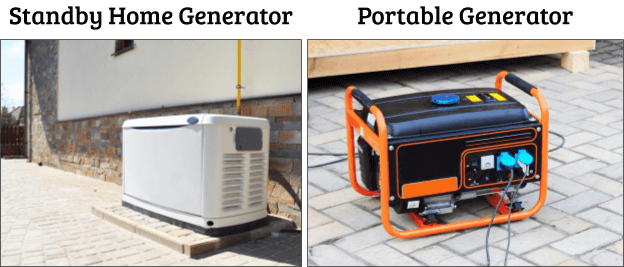
For some people, having their power go out is a mild inconvenience at best. However, if you work from home, need to use electrical medical equipment like a CPAP machine, have a deep freezer, or other electrical-dependent devices, having a backup power source can be a life-saver.
There are two options when it comes to having backup power—standby home generator and portable generator. To help you identify the differences, as well as the pros and cons of these two generator options, HedgeHog Electric is here for you.
DIFFERENCES BETWEEN STANDBY HOME GENERATOR OR PORTABLE
When it comes to deciding whether you need a standby home generator or a portable generator, one of the first things you need to know is how these generators differ.
The main difference is that a standby home generator will not move after installation by our residential electricians. On the other side, portable generators are just that—portable. Both of these machines need to operate outside, but you will need to find cover for the portable generator if needed. The standby generator will already have a weather cover.
Also, another significant difference in power generation. Depending on size and output, a portable generator can power a few select things, like your refrigerator and computer. Standby home generators are designed to power the entire household.
PROS AND CONS OF PORTABLE GENERATORS VS. STANDBY
Now that the differences between these two generators are clarified, you may have an idea of which one is right for your power needs. To help solidify your decision, here are the pros and cons of portable generators vs. standby home generators.
Portable Generator
Pros:
- Affordable – Depending on the size and electrical output, you can buy a portable generator for $400-$1,500. The power output is correlated with cost, so the more powerful portable generators will cost more.
- Portable – As it says in the name, the generator is portable. So, whether you move homes or want to take your generator when you go camping or to a cabin, it can easily be loaded up and come with you.
- Direct plug-in – If you don’t have your portable generator set up with a transfer switch, you can simply plug something directly into your generator and power the electrical device that way.
Cons:
- Set-up and break-down – To prevent dust, debris, and weather damage, your portable generator needs to be stored safely indoors when not in use. However, since you cannot use a portable generator indoors, you need to pull your generator out and set it up—then put it away—every time you use it.
- Noisy when in use – The motor in a portable generator tends to operate noisier than a home generator, which can be annoying when you need to use it.
- Needs weather cover – If a snowstorm or heavy weather of any kind is the cause of your power outage, you will need to have cover for your portable generator. Otherwise, water and debris can get into the air intake areas of the generator.
- Gasoline needed – Unlike standby generators, you can only use gas with a portable generator, which can get expensive. A portable generator can use between 12-20 gallons of gas per day.
- Lower power output provided – With their smaller size, portable generators put out lower amounts of electrical power. Depending on your generator, it may provide anywhere from 3,000-8,500 watts. Since an electric space heater can require 1,500 watts alone, portable generators don’t allow for as many things to be powered.
Standby Home Generator
Pros:
- Powers entire home – Unlike a portable generator, you don’t have to prioritize what a standby home generator power. With this heavier-duty generator, you can have your entire home powered during an outage.
- Worry-free – This type of generator is fairly worry-free. You don’t need to worry about having a weather cover, as they are designed to be in the open, they operate quietly, and can run for quite a while before needing refueling.
- Switches on automatically – As your standby home generator is hooked directly into your electrical system, if your home loses power, it will turn on automatically. So, you should only have a moment where you are without power before the generator takes up the slack.
- Fuel options – Depending on your standby generator, you may have the option to use natural gas or liquid propane. This type of generator can generally accommodate 13-48 gallons a day.
Cons:
- Cost – Significantly more expensive than a portable generator, a standby home generator can run you between $2,000 to about $5,000. However, that is only for the standby generator—having a concrete pad made, and the cost of installation can add another few thousand to costs.
- Installation – A standby home generator needs to be professionally installed by electricians. Otherwise, it will not be up to code, and the warranty will be void. However, you can have your standby generator easily installed by our electricians, making the task easier.
HAVE HEDGEHOG ELECTRIC INSTALL YOUR STANDBY HOME GENERATOR
Once you have considered your generator needs and decided that a standby home generator is what fits your home requirements, you can count on HedgeHog Electric to install your generator.
With the assistance of our electricians, you can get your home generator installed and safely connected to your home’s electrical system. That way, the next time a storm or rolling blackout takes down the main electric grid, you will have your generator to take up the slack.
If you would like to have a consultation concerning a standby home generator installation, feel free to contact us today.

